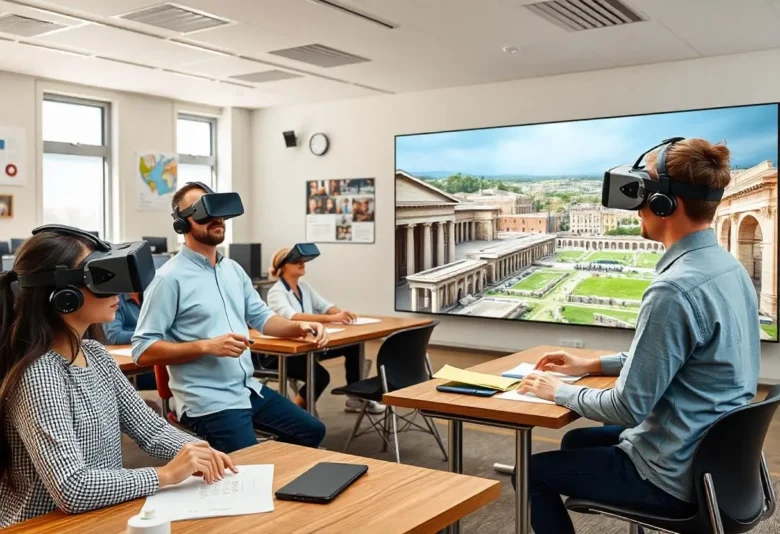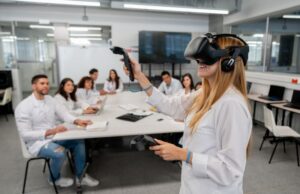Virtual classrooms have become an integral part of modern education. High-speed internet and digital learning technologies are transforming traditional classrooms at an unprecedented pace. The shift from physical to virtual classrooms not only impacts how students learn but also how teachers prepare, teach, and grade. This change impacts the entire education system, making learning easier and more convenient for both students and teachers.
The Rise of Online Learning Platforms
The rise of online learning platforms has been crucial in streamlining the learning experience in virtual classrooms. Google Classroom, Zoom, Microsoft Teams, and many other websites and applications are now ubiquitous in schools and colleges worldwide. These platforms offer features such as real-time communication, homework management, video conferencing, and collaborative learning. Students can now attend classes from home, access course materials anytime, and communicate directly with their teachers. This convenience increases students’ interest in school and makes it easier for them to meet their learning needs.
Accessible and Inclusive Education for All
Increasing accessibility and inclusion in education is one of the most important benefits of virtual classrooms. Students who would otherwise have difficulty accessing quality education due to their location, physical disability, or socioeconomic status can now access it without having to travel to a classroom. Virtual classrooms can be adapted to various learning styles. For example, you can add closed captioning, screen readers, and other features to make learning accessible to everyone. Furthermore, children in remote or disadvantaged areas now have access to previously inaccessible educational content.
Flexible Schedules
When it comes to schedules, virtual classrooms offer the most flexibility. Unlike regular classrooms with predetermined lesson times, online education allows students to learn at their pace. Students have access to recorded lectures, digital notes, and interactive modules at any time. This makes it easier to balance study with other responsibilities, such as work or family life. This flexibility is particularly useful for adults returning to school or studying part-time, as they can schedule their lessons around their schedule.
Giving Teachers More Control Over Technology
The virtual classroom revolution is also beneficial for teachers. Digital tools allow teachers to monitor student progress, provide immediate feedback, and use data analytics to understand their learning. This technology-focused approach helps teachers create more personalized lessons and identify struggling students early on. Virtual classrooms also help teachers develop their professional skills by teaching them how to use educational technology, manage digital content, and engage students online. Teaching in virtual classrooms requires new skills in many ways, which improves teachers’ overall effectiveness.
New Teaching Methods
Virtual classrooms help teachers explore new teaching methods. Schools are currently utilizing technologies such as gamification, interactive quizzes, virtual simulations, and augmented reality experiences. These technologies make learning more engaging and memorable, especially for children. Instead of relying solely on textbooks and lectures, teachers can now use videos, digital storytelling, and live demonstrations to explain challenging topics. This multimedia teaching approach captures attention and adapts to different types of students, making teaching more effective.
Bridging the Gap Between Knowledge and Practice
Virtual classrooms can help connect theoretical knowledge with practical applications. Online platforms can include case studies, simulations, and projects that simulate real-life problems. Students in fields like medicine, engineering, and business need this kind of hands-on training because they need to apply their classroom knowledge in real-world situations. Furthermore, virtual labs and collaboration tools allow students to try new things and work together on projects, regardless of their location. This experience of collaborating with people from around the world prepares students for the modern job market.
Challenges and Digital Divide
While virtual classrooms offer many benefits, they also pose challenges. A major problem is the digital divide, which means not all students have access to reliable internet connections or electronic devices. This inequality can make it harder for students to participate and lead to learning gaps. Some students also struggle with the lack of face-to-face interaction, which can undermine their motivation and social skills. Teachers also struggle to maintain order, stimulate student interest, and ensure academic integrity in virtual environments. Targeted policies, infrastructure investments, and innovative approaches are necessary to address these issues and ensure no student falls behind.
The Future of Education
The growing importance of virtual classrooms suggests that education will be a blend of multiple learning styles. Virtual learning is more likely to develop alongside traditional schools than replace them entirely. Hybrid approaches, which integrate both in-person and online learning, provide an optimal learning experience. These approaches retain the benefits of face-to-face interaction and community engagement while enabling flexibility, personalization, and innovative thinking. As technology continues to evolve, virtual classrooms will become even more immersive and engaging, ushering in a new era of student-centered, inclusive, and globally connected education.
Conclusion
There is no doubt that virtual classrooms enhance modern education by making it more accessible, adaptable, and open to everyone. Virtual classrooms empower students and teachers through technology, make learning more engaging and creative, and enable people from around the world to learn together. While virtual learning presents some challenges, such as the digital divide and a decline in face-to-face interaction, the benefits far outweigh its advantages. A balanced mix of virtual and physical classrooms could shape the future of education, ensuring that learning keeps pace with technological and societal developments.
FAQs
1. What is a virtual classroom?
A virtual classroom is a place where teachers and students can learn together online and communicate in real time via a digital platform. They can use tools like video conferencing, chat, and shared documents.
2. What are the benefits of virtual classrooms for students?
Virtual classrooms offer students more freedom to learn, personalized learning, and access to learning resources regardless of their location, making learning easier.
3. Are virtual classrooms as effective as traditional classrooms?
With the right tools and teaching methods, virtual classrooms can be just as effective as traditional classrooms. Virtual classrooms are especially effective when they offer interactive, engaging content tailored to each student’s needs.
4. What are the challenges of online learning?
Common challenges include lack of internet access, limited social skills, screen fatigue, and the need to learn time management and discipline.
5. Will online classes replace traditional schools?
Virtual classrooms are very useful, but they will complement rather than replace traditional education. This will lead to a hybrid model that balances both teaching styles.




